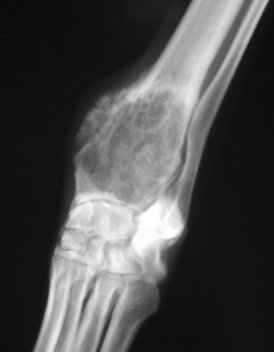
Osteosarcoma in Dogs
Osteosarcoma refers to the most common bone tumor found in dogs. Bone cancer can affect any breed of dog, but it is more commonly found in the larger breeds (ie., American Bulldog, Golden Retriever, Labrador Retriever, Rottweiler, Great Dane)
The disease is extremely aggressive and has a tendency to spread rapidly into other parts of the dog's body (metastasize). There are treatment options available, but generally the long term prognosis for the animal is poor.
Bone cancer can be found in cats as well, but it is rare.
Symptoms and Types
Many signs of bone cancer are subtle. They can include swelling, lameness, and joint or bone pain. In some cases, dogs suffering from bone cancer will appear tired or have anorexia. Occasionally, dogs will exhibit a mass growth on their body or a painful inflammation around the sight of the tumor.
Causes
Current knowledge of the disease has not linked genetics or gender to the condition, but bone cancer does appear more often in large to giant breeds of dogs. Some studies have shown a slight increase in the development of osteosarcoma among dogs that have experienced a blunt bone injury.
Diagnosis
Your veterinarian will use X-rays to view the mass, often using several angles to get an accurate picture. Other tests include biopsies, blood tests, bone scans, and CAT scans to view the bone areas, and the mass, if discovered. If the diagnosis is bone cancer, it is important to note that the prognosis is often unfavorable and that there are numerous side effects to the treatment options. Management on your part will be required.
Treatment
Chemotherapy is often used as a supplement to any surgical options to ensure that the disease has not spread into other areas of the dog's body, particularly the lymph nodes. In severe cases, limbs may need to be amputated to completely remove the bone cancer.
Living and Management
Activity will be restricted following any surgery. A pain management program and medications are frequently prescribed for the animal following surgery. Medications commonly work to manage pain and reduce inflammation. Ongoing management and monitoring of the dog's white and red blood cell counts will be recommended, and chest X-rays are often used to determine remission.
Prevention
There are currently no known prevention methods for bone cancer.
Osteosarcoma refers to the most common bone tumor found in dogs. Bone cancer can affect any breed of dog, but it is more commonly found in the larger breeds (ie., American Bulldog, Golden Retriever, Labrador Retriever, Rottweiler, Great Dane)
The disease is extremely aggressive and has a tendency to spread rapidly into other parts of the dog's body (metastasize). There are treatment options available, but generally the long term prognosis for the animal is poor.
Bone cancer can be found in cats as well, but it is rare.
Symptoms and Types
Many signs of bone cancer are subtle. They can include swelling, lameness, and joint or bone pain. In some cases, dogs suffering from bone cancer will appear tired or have anorexia. Occasionally, dogs will exhibit a mass growth on their body or a painful inflammation around the sight of the tumor.
Causes
Current knowledge of the disease has not linked genetics or gender to the condition, but bone cancer does appear more often in large to giant breeds of dogs. Some studies have shown a slight increase in the development of osteosarcoma among dogs that have experienced a blunt bone injury.
Diagnosis
Your veterinarian will use X-rays to view the mass, often using several angles to get an accurate picture. Other tests include biopsies, blood tests, bone scans, and CAT scans to view the bone areas, and the mass, if discovered. If the diagnosis is bone cancer, it is important to note that the prognosis is often unfavorable and that there are numerous side effects to the treatment options. Management on your part will be required.
Treatment
Chemotherapy is often used as a supplement to any surgical options to ensure that the disease has not spread into other areas of the dog's body, particularly the lymph nodes. In severe cases, limbs may need to be amputated to completely remove the bone cancer.
Living and Management
Activity will be restricted following any surgery. A pain management program and medications are frequently prescribed for the animal following surgery. Medications commonly work to manage pain and reduce inflammation. Ongoing management and monitoring of the dog's white and red blood cell counts will be recommended, and chest X-rays are often used to determine remission.
Prevention
There are currently no known prevention methods for bone cancer.

 RSS Feed
RSS Feed
